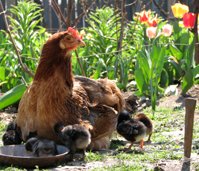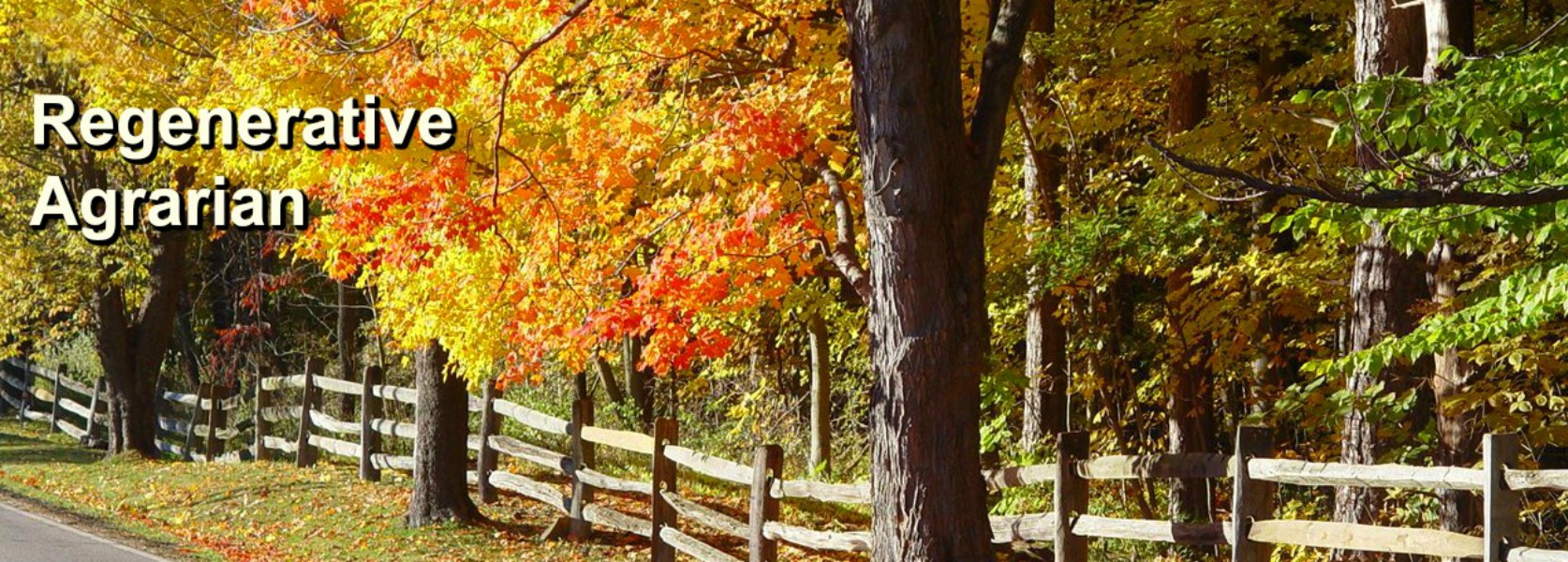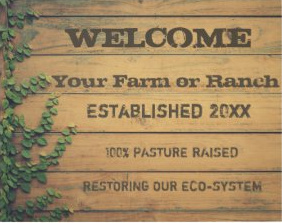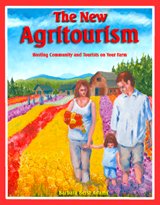Regenerative and humane, the story of a small meat and egg farm

First published by Barbara Berst Adams in AcresUSA
Photo is stock. Text copyright National Lilac Publishing, LLC
In the small rural town of Trout Lake, Washington, husband and wife Michael Kelly and Rebecca Wellman operate Treebird Organics, a deeply thoughtful and beyond organic pastured pork, beef, and egg farm on about 60 acres. Forty-four of those acres are family owned, and this year 10 nearby additional acres (20 additional acres in the recent past) are leased. They have also raised broilers and heritage turkeys and are working towards offering poultry meat through their new WSDA (Washington State Department of Agriculture) approved on-farm processing system currently in the making. Their eggs are sold via nearby farmers' markets in both Washington and Oregon, from their on-farm store which is open year-round by appointment, and through the farmers' new CSA club which offers a meat only or meat and eggs option.
Their eggs are both certified organic and Animal Welfare Approved (AWA), with the farmers stating they felt AWA was the most stringent in their rules regarding humane treatment, helping the farmers achieve the highest standards possible for their laying hens and other animals. Treebird Organics’ eggs were even named the number one eggs in the country by the Cornucopia Institute. That organization researches and investigates family-scale ecological farming and shares its information with other farmers, the media, consumers and others involved in what they call the “good food movement.” Its 28 scoring criterion for quality egg production include either rotating birds in mobile coops to pasture or providing rotating pasture with fixed housing, selling eggs locally and/or regionally, obtaining organic certification, and providing adequate indoor space for the birds. All of that and more take place on Treebird Organics’ farm. In fact, the eggs are hand collected once or twice a day depending on weather and time of year, then personally inspected and hand packed for quality by the farm owners. “Everything is done with good old fashioned labor,” Kelly said. “No machines here.”
The year-round pasturing system
At this writing, Treebird Organics had about 350 working (laying) hens on pasture. The farmers raise their own replacement chicks and retire hens after two laying cycles when they’re usually around two and a half years old. Their poultry operation is integrated into their other various livestock and gardening projects in a mutually beneficial manner, utilizing interspecies grazing and rotational pasturing. They have witnessed the benefits of combining their poultry with their ruminants (animals with four-compartment stomachs, such as their cattle) along with further benefits derived from intermingling them with their monogastric (animals one-compartment stomachs) pigs. They are well-grounded yet dynamic farmers, always adapting, innovating and improving their systems. Their current pasturing routine is as follows:
- Cattle graze for four to seven days until the grass is eaten down to three to four inches. As the Treebird Organics farmers explain, if allowed to eat below that height, it can take nearly twice as long for the grass to grow back, allowing less desirable plants including weeds to expand.
- After this initial period, the cattle are moved to new pasture.
- Then they put poultry into the last paddock the cattle were in.
- Kelly further explained how they also integrate the laying hens with their pigs. “Just like with the cattle,” he said, “the chickens can help clean up after the pigs have been through an area. Regarding the current areas where pigs are raised on the farm, he explained that they don’t yet put the pigs on their prime pastures. “Pigs root it up and make the fields very bumpy,” he said, “so we move them through the edges and other areas that aren’t so flat. Eventually we will have all the animals everywhere since they all work together to create really cool -- and healthy -- ecosystems. The pigs can actually help improve micro watersheds on the farm by rooting and wallowing. In a few areas where the pigs have been, we are already seeing better water retention in our very dry soils. Its great to see the animals -- not us -- bringing life back to these soils that used to be a healthy forest, but have been intensively farmed for decades and were fairly deplete of organic matter and trace minerals.”
The integration of Kelly and Wellman’s poultry with their other livestock provides further feeding benefits for their poultry. “All of the animals eat at different horizons,” Kelly said. “The cattle are going for the fresh green growing grass. The pigs and chickens also like the fresh growth, but pigs also like the roots and grubs and rodents. Chickens also eat the bugs that are left from the dung of both other animals and help spread the manure around. Chickens are also carnivores… I’ve watched chickens chase and eat small rodents.” Kelly noted he didn’t believe in the concept of vegetarian fed chickens because they are natural omnivores. “100% vegetarian fed chickens is inhumane in mine and other people’s opinions,” he said.
With all this freeranging going on, it can be handy having a livestock guardian dog take charge of the pastured hens’ safety. The farmers’ Great Pyrenees, Oly, protects the chickens from the many possible predators that frequent their acreage, staying with them day and night. Kelly and Wellman only occasionally utilize temporary poultry fencing. “Certain times of the year the hens get more curious and we put up the poultry wire to keep them a little closer to the coop -- partially for their own protection,” Kelly explained. But often only their farm’s perimeter fencing is needed to keep the hens safely where the farmers want them to be. This helps out with labor when it comes to moving the hens’ housing to new pasture. “I prefer to have no fencing up,” Kelly said, “because this allows the birds to truly range and it makes it easier for me to keep their coop moving since I don’t have to move the poultry wire fencing each time.”
The poultry houses themselves are on-farm creations that have evolved over the years. “We built all of our portable housing on the farm with our own design,” Kelly said. For their broilers, they started with designs inspired by Joel Salatin’s work, then eventually free ranged them with only a movable roost. “They taste way better when they can run around,” Kelly said. “For layers, we now have two mobile houses that we built all to AWA specs for covered square footage, and roost and nest space.”
Although some mobile pastured poultry setups incorporate bottomless housing, Treebird Organics uses housing with solid floors, and though bottomless housing can have some advantages, Kelly and Wellman have found advantages to solid flooring as well for their particular situation. “AWA does not allow for grated floors,” Michael said, “and because of our cold winters, we wanted to be able to have them go in a warmer space (no floor would be very cold). It does add to my labor since I have to clean the coops pretty regularly to keep the ammonia smell down. AWA does not allow for an ammonia buildup at all (they say if you can smell it, it’s too much), so during certain times of year we have to clean each coop weekly and put in fresh bedding. Sometimes I wish I had bottomless pens to avoid the coop cleaning, but for the most part I am very happy with our coops. Having solid bottoms also allows us to close the chickens in if we need to move them further around the farm. Otherwise, if the hens aren’t locked in, you can only move them 30-40 feet at a time so they can still find the coop.”
During the warmer months when pasture is growing the most, the laying hens and their mobile houses are moved more often which provide them with a diversity of live growing greens and many active insects. Year-round, they have access to the outdoors by choice which provides natural light, fresh air, and space to do what chickens instinctively seek to do including normal socializing, dust bathing, scratching the earth, and foraging.
In winter, though the poultry still access the pastures, the farmers adjust their routine to the colder temperatures. “Things slow down in the winter,” Kelly said. “We don’t rotate quite as often due to not as much fresh green growing grass. We move them every few weeks so they don’t get a buildup of manure and parasites around the coops and housing areas. Mostly our winter routine changes because the animals spend so much more time indoors or under cover of trees -- by choice -- so we have to clean the indoor and covered areas much more often. During much of the winter, it has to be cleaned daily in order to maintain good air quality to meet AWA standards.”
The hens get a winter food boost from organic hay as well as produce from the farmers’ own garden. “We also start supplementing all the animals with alfalfa and grass hay,” Kelly said, “so they always have good quality greens in their diet. With the chickens and pigs, they also get more garden scraps and veggies that we froze for them from the previous year. We work harder in the winter to insure that they have a clean, comfortable place to live out of the elements and plenty of great food to eat. It’s worth the work though. A happy hen is a laying hen, so if we keep them happy, they will keep giving us eggs. Otherwise egg laying really drops off in the winter and we can’t really afford to have them around if they aren’t working. Same with the meat animals. They really don’t put on meat if they aren’t warm and getting really good quality feed. If a meat animal is allowed to lose weight in the winter, the meat will be tough -- nobody wants tough meat.”
When it comes to supplementing with grain, Kelly and Wellman are happy to have recently connected with a nearby supplier that meets all their needs, including AWA approval which only allows the use of fish meals coming from waste products and not directly from wild caught or farmed fish. Kelly said that has been a challenge because fish meal is a significant protein source for many organic feeds. The farmers initially made their own feed, but found that a premix was more cost effective, including when adding labor into the cost. So for a while, they used an AWA approved mix sourced from Montana. But eventually, Scratch and Peck, a supplier right in their own state in Bellingham, Washington and one which they’d been talking with for years, started using AWA approved fish meal. Kelly stated he’s also happy with where they source their grains. “They claim to get most of their grains from our bio-region which I think includes Washington, Oregon, California, Idaho and possibly a little further,” he said. “They are also looking at using bugs for protein which can be grown locally rather than fish meal which can come from all over the planet. Annual grains are our biggest input on our farm so we are excited to at least be getting more local grains now. The growing, transport and storage of annual grains is extremely energy intensive, so we are working hard to be as efficient with those grains as we can be.” One way the farmers help make their grain usage efficient is by using animal breeds that get the most out of pastures and need as little grain as possible. They’re also careful about making sure their animals actually eat all the grains offered without wasting any.
Scratch and Peck states their chicken, turkey and other feeds are certified organic, non-GMO Project Verified, and soy and canola free. They also offer a corn free mix, which is the one Treebird Organics uses. The ingredients they list for their corn-free layer feed are: organic wheat, organic barley, organic peas, organic linseed meal, ground limestone, oyster shell, fish meal, vitamin and mineral premix, organic sesame meal, and organic vegetable oil.
Experience with various chicken breeds
When considering profit margins with eggs, the other work the egg-layers provide (besides eggs to sell) can also be taken into account regarding their financial contribution. In some cases, they not only contribute directly to the farm itself, but to society in general. Chickens, as we’ve seen, reduce livestock parasites, provide compost material, and rejuvenate pastures, all of which cuts back on purchased substances and mechanical means of achieving these goals. Also, the farmers are not handing massive amounts of their uncomposted chicken manure waste over to outside systems that allow it to pollute our natural resources which eventually costs more money to society. From that point of view, the pastured eggs’ monetary value appears even larger.
Still, farmers need to profit here and now with cash flow in a world where customers can be used to eggs that are cheap at the point of purchase, but unknown to them, costly to the environment and society down the road. Kelly and Wellman continue to look for ways to increase profit from their egg sales, including discerning which breeds work the best for them. “We currently have Rhode Island Reds,” Kelly said. “We have raised Buff Orpingtons, Black Australorps, Araucanías and more, and have found the Rhode Island Reds produce the best in our climate. We are also going to be trying the Novogen Brown Sex Link next year since the AWA guidelines now allow for hybrids as long as they can be raised in a healthy way -- healthy for the animals. We are going to give them a try in an attempt to make the egg business pencil out a little better. As it is now, the margins are very tight on eggs.”
Future poultry meat plans
Rules governing food safety, including the slaughter and processing of poultry for meat, are complex. There are federal, state and local regulations to decipher. Depending on one’s location and goals, they can take careful study and professional consultation to interpret properly. This can be especially true in the case where a farm’s local customers cross state borders, as is the case with Treebird Organics that operates in Washington very near the border of Oregon, where even more local eager customers await. But when off-farm required federal and/or state inspected and approved facilities have to be used for slaughter and further processing, while they meet food safety standards, they don’t always meet the further standards of the farmers who want humane treatment of their animals and the ability to sell legally processed meat from their own farms. (Your own county extension service can lead you to material describing specific regulations for your area. Although there are online sources, realize the rules change often, and online sources may not be up to date.)
Treebird Organics wants to safely, legally, and humanely expand their poultry meat sales following higher humane standards than the current approved slaughtering facilities available in their area. One service that could have been of use for their goal as well as other local meat producers across the country is a USDA approved mobile meat processing unit that comes right to the farm. Without these, farmers and ranchers using USDA approved facilities often have to transport their live animals far away. USDA approved mobile meat processing units that come right to the farm have numerous advantages for local food distribution as well as being more humane for the animals by avoiding the animals’ fear and confusion when traveling miles away, and then entering a place that emits fear, pain and death. Dr. Temple Grandin, who teaches and advocates for humane meat animal slaughter, has stated her support of these units. Economically for the farmer as well as for local food sustainability, on-farm USDA approved processing more easily allows smaller and local producers to choose and serve their own niche markets, including selling legally fully processed meats directly from their farm.
However, these units aren’t available yet in Treebird Organics’ location, though the farmers stated they’d love to have one available. So in the meantime, they are working towards a WSDA food processing license for their own farm. While this won’t open the doors to all their nearby market outlets, it does expand what they can legally sell. “We retire the hens after two laying cycles,” Kelly said. “AWA requires humane kill if we are going to sell them, so we are working on getting our place set up for WSDA and AWA approved kill. We plan on having this set up by our next big butcher date which will be in 2018. This allows us to sell the birds from our farm, but not at farmers markets in Oregon.” Kelly believes the chicken meat from their farm will be well enjoyed. “I personally think that stewing hens -- when cooked correctly -- are the best tasting chicken available -- especially ours,” he added.
In the past when the Treebird Organics also produced heritage turkeys, the birds were even allowed natural flight, living more like wild turkeys with the bonus of organic grain and the guardianship of Oly. Their wings weren’t clipped and they enjoyed roosting in the trees. Kelly and Wellman aren’t raising them currently anymore while they work on improving and expanding their egg, beef and pork operations and achieving their new license. But that might change. “On farm poultry processing will be for broilers, layers and possibly turkeys,” Kelly said. “We are just not going to raise turkeys this coming year, but will try to add them back in, in the future.”
Treebird Organics, in its Trout Lake, Washington location, is part of a network of people and organizations around southwest Washington and northwest Oregon dedicated to expanding sustainable and regenerative local and regional food supplies in their bio-region. When one sees the contented expression of Oly resting in the fields, hears the chatter of hens bustling about as nature intended, and a best egg award comes from that, there is no doubt Treebird Organics is a great contribution to that goal.
---------
Would animal welfare certification benefit your poultry operation?
If animal well-being and environmental sustainability are priorities for your poultry farm and its customers, would it benefit your poultry operation to become certified? There are several certifying organizations available, all with varying degrees of standards, such as Certified Humane, Global Animal Partnership, and Treebird Organics’ choice, Animal Welfare Approved. According to MarketWatch, AWA is currently the gold standard of certifying programs.
Here’s a partial description of AWA from their website:
“Animal Welfare Approved (AWA) is a food label for meat and dairy products that come from farm animals raised to the highest animal welfare and environmental standards. The program was founded in 2006 as a market-based solution to the growing consumer demand for meat, eggs and dairy products from animals treated with high welfare and managed with the environment in mind.”
AWA acknowledges that when animals are treated incorrectly, it not only causes suffering for the animals, but endangers the health of people and the environment as well. The good news is that there is growing consumer awareness of undesireable livestock treatment which can influence customer demand for products from farms with high animal and environmental welfare methods of farming.
Farmers who consider third-party certifiers including AWA can answer the following questions to help determine their answer. First off, does the farm have customers (or seek customers) who value farm animal and environmental well-being yet who aren’t able to visit and tour the farm? If so, a third party label may help reassure them and attract them to purchase. AWA farmers can be listed on the organization’s website as a source of promotion for the farm’s products. Also, does the farmer him/herself want to learn more about animal welfare and operate under those guidelines regardless of customer demand? It isn’t always obvious what needs specific types animals have, and even animal companions have been innocently “loved to death” by well-meaning owners who didn’t understand the specific needs of that species.
Though certification is cost-free to farmers, the costs of changes to the farming system can add up. Yet innovation is allowed regarding what works for each individual farm, and if a single guardian dog can replace costly labor and fencing year round while meeting the guidelines, then money can actually be saved. Highly trained AWA agents visit the farm in person, and depending on the farm’s current situation, farmers say that compliance isn’t always easy but that AWA is very helpful. They feel compliance is worth it, also, especially when they explain the high standards to their customers who become loyal and eager for more of their products because of the care going into them. The list of AWA standards and other helpful information are on their website. www.certifiedawa.org





